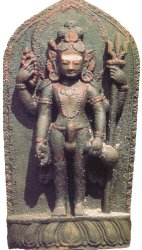PENIS

The penis (aïgajàta, liõga, muttakaraõa, pulliõga, purisavya¤jana or subhalakkhaõa) is the long fleshy appendage in males used for urination and reproduction. According to the Tipiñaka, one of the 32 Signs of a Great Man is that `the cloth-hidden is encased in a sheath' (kosohitavatthaguyha, M.II,135). This was interpreted to mean that the Buddha's penis could be drawn into the body and remain there as with some animals like horses, cattle and elephants. The Gaõóhavyåha, a Mahàyàna work, says: `His genitals were ensheathed, well hidden deep in the body as with a thoroughbred elephant or stallion. Even when naked, any woman, man, youth or girl, old, middle-aged or young person, whether lustful or potentially lustful, on seeing him would not have even the least desire.'
Many of the Signs of a Great Man seem strange to the modern mind. Others, however, including this one, probably had their origins in the ancient Indian concept of idealized beauty and auspiciousness. So, for example, the banyan tree was considered sacred, and the Buddha is supposed to have had the proportions of a banyan tree (nigrodha parimaõóala), i.e. the length of his outstretched arms equalled his height. He is supposed to have had long curved eye lashes (gopakhuma) and a very long tongue (pahåtajivhà), both of which are features of the cow, an animal the Indians greatly revered.
Like the Greeks and Romans, the ancient Indians were great admirers of the human form including all aspects of the male physique. According to the èg Veda, an attractive penis would be big and thick like a club. The Atharva Veda has a prayer to make the penis long and hard like a taut bow and also contains spells to make it as long as that of the wild ass, the elephant or the stallion. The Ràmàyana on the other hand, describes the auspicious man as having a slender, short penis with a smooth glans and drooping testicles. The Buddha seems to have had an aesthetic appreciation for this part of the male anatomy too. When referring to the penis he usually used the common polite words but sometimes used the more poetic term `the highest limb' (uttamaïga, Ja.V,197). It seems probable that like the ancient Greeks, the Buddha's contemporaries considered having a penis whose foreskin (kosa) remained over the glans (makula) when either flaccid or erect, to be a sign of beauty and nobility and that at a later period this physical characteristic was attributed to the Buddha. It is worth noting that even some unenlightened men are mentioned as having a penis like this (e.g. Ja.V,197; Mahàvaüsa VI.11;57; Sn.1022).
According to the Lakkhaõa Sutta, a late addition to the Tipiñaka, all the 32 Signs of a Great Man were physical manifestations of good deeds done in former lives. Thus as a result of always speaking kindly and gently the Buddha was reborn with a long tongue. Because as a teacher he helped his students quickly understand what was being taught he was reborn with legs like a swift-running deer. And because he united long lost family members and friends `so that they rejoiced greatly' he was reborn with an ensheathed penis (D.III,160-1).
The penis has a significance in the Vinaya, Buddhist monastic rules. A monk or nun will be expelled from the monastic order if they commit four offences, one of which is sexual intercourse (methuna). So that there can be no ambiguity as to exactly what constitutes sexual intercourse, this behaviour defined exactly. According to the Vinaya, sexual intercourse is deemed to have occurred if the penis enters either the vagina, anus or mouth of any being, living or dead, even for the length of a sesame seed (tilaphala, Vin.III,28), i.e. slightly less than 3 millimetres. Other types of sexual behaviour, while serious offences with specific punishments, do not entail expulsion from the Saïgha.